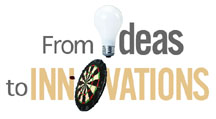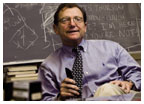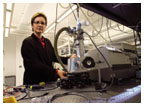
|
March 22, 2006: Features

Technologies
that could change the world
By Brett Tomlinson
Brett Tomlinson is an associate editor at PAW.
(Title photographs: Corbis; Stockbyte)
For laboratory scientists and engineers, inspiration has many sources, from the systems of the human body to the brake lights of the cars on the New Jersey Turnpike. But turning brainstorms into breakthroughs is tricky business. Technologies evolve through a series of small victories and defeats, inching toward the goal of improving the world, or at least some small part of it. PAW spoke with five Princetonians to get insights into their current work and the important advances it could yield.
Professor Winston Soboyejo, sitting, with graduate students, from left, Jianbo Chen and Yifang Cao. (Ricardo Barros) |
Thinking small with nano-medicine
Winston Soboyejo, professor of mechanical and aerospace engineering
In the human bloodstream, size matters. Mechanisms in the immune system excel at detecting foreign particles and turning on the body’s defenses against unfamiliar substances. But the tiniest of particles can sneak past the bloodstream’s gatekeepers, opening up a range of imaginative possibilities in disease detection, drug delivery, and immunization. The ideas, Winston Soboyejo says, once seemed like “fairy tales,” but modern technology is moving them closer to reality.
Take, for example, Soboyejo’s project to improve the resolution in the magnetic resonance imaging (MRI) of breast and prostate cancer. With the resolution of today’s MRI scanners, clinicians can detect tumors a few millimeters in size. But tumors at that point could contain hundreds of millions of cancer cells, Soboyejo says.
To improve MRI resolution, Soboyejo and his colleagues developed a nanoparticle designed to seek out breast and prostate cancer cells. The cancer cells overexpress receptors for luteinizing hormone-releasing hormone, or LHRH, which is responsible for regulating the production of estrogen and testosterone. In cancer cells, there are about four times as many receptors for LHRH as in normal breast or prostate cells, so Soboyejo’s team tagged LHRH to particles of magnetite, a compound of iron and oxygen, in hopes of directing nanoparticles toward cancer cells. With each particle about 15 nanometers wide — more than 6,000 of them lined up side by side would span the width of a human hair — the particles were able to work their way through blood vessels and capillaries to find breast and prostate tumors in a study on mice. The nanoparticles also located metastasis in the mice’s lungs. Magnetite displays clearly on MRI scans, enabling an earlier diagnosis of cancer.
With proof that his idea works, Soboyejo is moving forward on MRI applications that would work with existing technology so hospitals could improve their results without having to retool their imaging labs. But like others in his field, he has his eyes on nano solutions to mega problems, including cancer-drug delivery. Therapy for cancer often introduces toxicity to the whole body, not just to tumors. By delivering drugs with more precision, doctors could cut dosage, improve effectiveness, and reduce side effects. To that end, Soboyejo is exploring strategies to combine nanoparticles and existing drugs in a “nanoparticle cocktail” that would find and treat tumors. “I think that’s where the real breakthroughs could be made,” he says.
Medical nanoparticles are still in their infancy, but Soboyejo’s encouraging results have opened doors in an area of research that was completely new for the professor just a few years ago. As a Ph.D. student at Cambridge University and later as a junior professor and industry researcher, Soboyejo’s specialty had been the fatigue and fracture of aerospace materials. But a sabbatical year at MIT allowed him to rethink his career path. Biomaterials piqued his interest, and when he came to Princeton in 1999, a fresh start enabled him to pursue new research. “I actually find that although I did take a risk — and there’s no question that I gave up a lot of funding that I would have gotten in other areas — I think the work is more exciting,” Soboyejo says. “I attract more students of the type that I want, and overall, I have more fun.”
Alain Kornhauser
*71 |
Steering clear of traffic trouble
Alain Kornhauser *71, professor of operations research and financial
engineering
On the highway, Alain Kornhauser may not be the person you want to see driving next to you. While advising a student group that designed a “self-driving” truck for last year’s DARPA Grand Challenge, a Department of Defense contest, he tested how often one needs to update readings of road conditions by driving with his eyes closed and opening them at different intervals. But blind driving aside, Kornhauser has the best interests of his fellow motorists in mind, particularly in an ongoing project that aims to reduce traffic jams.
The concept seems relatively simple: Using data points from global positioning system (GPS) devices in cars, Kornhauser’s application could calculate up-to-date information on the speed of traffic on particular roads, and by feeding that data into mapping software, an in-vehicle device could recommend the fastest route to a given destination. “Depending on where you are and the conditions ahead, it solves an optimization problem, just like we teach [in his courses],” he says. The comprehensive and timely information would be a monumental upgrade over the sparse and outdated radio reports on which many drivers rely.
In a 2005 study of about 250 GPS-equipped drivers in and around Troy, N.Y., the CoPilot system developed by Kornhauser and his company, ALK Technologies, showed that a limited number of signals can paint an accurate picture of local traffic. But to be effective nationwide, Kornhauser says he would need a million drivers sending periodic GPS signals.
Finding a million subscribers is a staggering challenge. Kornhauser’s interim plan is to market CoPilot’s mapping software, which can be downloaded to handheld organizers and GPS-equipped mobile phones. But there may be an alternative solution: using regular cellular phones instead of GPS devices. Cell phone carriers are constantly updating the positions of their subscribers’ phones to ensure accurate routing of calls. So each time a phone moves from one cell-tower zone to another, the companies write a time-stamped record. Zone position is not nearly as precise as GPS, but by tracking a phone’s progress through a series of zones, one can make a reasonable guess of the major roads on which a user might be driving. And the sheer volume of mobile phones builds a mountain of information, organized in digestible records of just a few bytes each.
While Kornhauser is a proponent of the GPS solution — his business card lists the GPS location of his desk, “74.651156W; 40.350216N” — he is open to pursuing the cell-phone route if it makes the system work (and if the cell carriers are willing to share the data for a reasonable price). After all, optimization is the driving force behind his work — that and an obsession with transportation. Kornhauser, who also studies mass transit, seems slightly ambivalent about making driving a more attractive option. “It’s not that we want to encourage more driving,” he says. “It’s just that it’s a waste of time for us all to be stuck.”
Delivering hand-held health care
Paul Yager ’75, University of Washington bioengineering professor
As an undergraduate biochemistry major, Paul Yager ’75 says he “briefly flirted with the idea of going to medical school,” but his true love was lab science. Working under Professor Thomas Spiro, he completed a thesis titled “Polarized Resonance Raman Spectroscopy of B-Carotene in Phospholipid Monolayers,” an esoteric undertaking he now summarizes as “shining bright lights into very small volumes of liquid and chasing photons around the room.”
Small volumes of liquid, it turns out, eventually led Yager back to medicine, though not as a clinician. Using his expertise in microfluidics, the bioengineer at the University of Washington is working to create portable diagnostic devices to improve health care in the developing world.
The medical diagnostics field is well established, Yager says. In hospital labs, complex machines give accurate readings that help doctors diagnose and treat patients. But it takes time, and it requires expensive equipment that may not be accessible to some of the people who need it most. In dispersed populations like some in sub-Saharan Africa, for example, building high-tech labs may not be the most effective solution. Instead, Yager envisions bringing lab-quality results directly to the patient, with devices that fit in the palm of the doctor’s hand. Thanks to a $15.4 million Grand Challenges grant from the Bill and Melinda Gates Foundation, he and his collaborators are working to do just that.
Yager’s system relies on two components: a hand-held diagnostic computer and a chemically treated card with tiny embedded slits, analogous to the circuits on a computer chip. The computer would be similar to the blood-glucose meters used by patients with type-1 diabetes, but its scope is much more complex. A finger-prick’s worth of blood would be placed on the diagnostic card, and the card inserted into the computer. A mechanism in the computer would then pump the blood sample through the slits in the card, allowing the blood to mix with chemicals that test for several pathogens. The presence of a pathogen would trigger reactions that display a color or fluorescence in transparent windows on the card, from which the computer would read a diagnosis.
Easier said than done, of course. Yager’s device would be aimed at deciphering the cause of rapid-onset high fever, a symptom common to diseases such as typhoid, malaria, and measles. In world health, it is a significant problem because incorrect diagnoses lead to treatments that can cause harm, allow wider outbreaks, and waste limited medical resources. But testing for the full range of diseases that cause such fever requires two different kinds of tests — nucleic acid-based tests, which use DNA; and immunoassay tests, which use antibodies. Running both tests on the same sample is one of many unsolved riddles for Yager’s team.
On a broader scale, the researchers and their corporate partners have to come up with a cost-effective device — and do it quickly, as his Gates Foundation grant lasts five years. But bioengineers, Yager says, are well suited to the task. “If bioengineers are characterized by anything in particular,” he says, “it’s the fact that we can never allow ourselves to get terribly far from the end use.”
Claire Gmachl |
Harnessing the light of a 'lab curiosity'
Claire Gmachl, associate professor of electrical engineering
For a complex technological device, the quantum cascade laser has remarkably simple operating instructions: “You put current in, you get light out,” says Claire Gmachl, with a tone of mild-mannered modesty. Gmachl, who followed an appearance in Popular Science magazine’s “Brilliant 10” list of young scientists in 2004 with a MacArthur Founda-tion “genius grant” last fall, is as unpretentious as the device that has become her specialty. The basic mechanism in the quantum cascade laser is the same as the one in a hand-held laser pointer, she says, but its light is very different. Each quantum cascade laser uses about a thousand layers of custom- designed crystals, arranged in a total width of two micrometers, to produce a specific wavelength of invisible light.
Why would anyone go to such exacting extremes to produce invisible light? The question was still an open one when Bell Laboratories began developing quantum cascade lasers in the mid-1990s. Gmachl worked at the labs shortly after the technology was discovered, and it was merely a “lab curiosity” at first, she says. But applications soon surfaced, predominantly in the field of chemical detection, where the device was able to exploit the ways in which different gases absorb invisible light. “Every chemical has its very own fingerprint of absorption features,” Gmachl says, “so you can tailor your laser to the absorption features of a gas or a gas mixture.”
Based on the amount of light absorbed by a sample of air, the laser can measure the presence of a gas with remarkable precision. And its size (think of the laser pointer) means that it can be used in devices much smaller than the best sensing equipment available today. The concept could be used to measure pollutants in the air, spot chemical agents released by bioterrorists, or detect trace amounts of toxins in the breath of someone who is ill.
Breath analyzers are among the most intriguing applications. For patients receiving dialysis or liver medication, signs of poor kidney or liver function turn up as chemicals in the blood stream, which in turn enter the lungs and are ultimately exhaled. Gmachl and her colleagues envision a portable breath monitor — ideally the size of a keychain — that could measure important chemicals, such as ammonia, to tell doctors and patients how well treatment is working without the need for a blood test.
As applications develop, quantum cascade laser research continues to grow — and with Gmachl’s help, Princeton has become a key player in the field. She is working to create a multi-university center with Princeton as the lead institution, collaborating with six other colleges, including Rice and Johns Hopkins. Better organization and cooperation could lead to faster strides in the field and in Gmachl’s lab. “We don’t have a lack of projects or ideas,” she says. “The harder part is prioritizing them and scheduling to make the most out of them.”
James Broach |
Sensing chemicals with an artificial sniff
James Broach, professor of molecular biology
When it comes to differentiating chemicals, the nose knows best, according to molecular biologist James Broach. It is a chemical detector par excellence, with 800 receptors working in a multitude of combinations to identify about 10,000 different compounds. The 2004 Nobel Prize-winning work of researchers Richard Axel and Linda Buck clarified the once-enigmatic combinatorial process, showing that each chemical compound lights up a mix of receptors. Based on the combination, the olfactory system can identify the odorant molecule. Using that knowledge, Broach hopes to replicate that system and create powerful, durable environmental detectors.
Broach’s work simulates olfaction by inserting receptors into genetically engineered yeast cells. Expressing olfactory receptors outside the nose is extremely difficult, so Broach has taken a different approach: He uses other kinds of naturally occurring chemical receptors that behave like smell receptors. Each yeast cell holds a receptor that can respond to more than one compound, and a given compound can trigger the receptors in more than one variety of yeast. “It’s sort of an end-run around the problem because it allows us to test hypotheses about how olfactory decoding might happen by being able to create our own [system],” he says. “But it’s also technically very satisfying because if you start with olfactory receptors, then you can generate a detector that can detect what we can already detect with our noses. If we start with new receptors, we can basically make a nose that can smell things that we can’t smell.”
Broach exposes the modified yeast cells to different compounds, and when a compound triggers the receptor, it also triggers fluorescence in the yeast. By observing which receptors “light up,” he can identify a specific compound. So far, the work has proved challenging — Broach has produced only about a dozen receptors — but with each new receptor, the number of compounds he can decipher grows exponentially.
On the research continuum, the work is closer to the fundamental than to the applied, but Broach has applications in mind. When the system becomes more powerful, with more receptors, collaborators in nanofabrication could use the technology to create a small but robust device, about the size of a quarter, with thousands of yeast cells imbedded to detect chemicals. It would be “the size of the nose, with potentially the discriminatory power of the nose, that could be put out anyplace,” he says, making it easy to deploy in large numbers of detectors to monitor industrial emissions or vast biological systems such as oceans.
Broach’s ideas don’t end there. He also imagines engineering tailored smell receptors and inserting them into fruit flies to alter their behavior. For instance, the fruit flies could be programmed to detect the odor of C3 explosive instead of decaying fruit, enabling them to help find long-forgotten land mines.
It may seem peculiar or far-fetched, but not to Broach and his colleagues.
And in many cases, the exploration begins with fundamental research. “Then
the ideas or the solutions come,” Broach says, “and often
not from the direction that we would have guessed that they would have
come from. There’s always an application.” ![]()




